Study Skills and Corporate Social Responsibility
VerifiedAdded on 2020/10/22
|10
|2830
|103
Report
AI Summary
This report discusses the significance of study skills in enhancing individual learning efficiency and the role of corporate social responsibility (CSR) in business practices. It includes a literature review on CSR, highlighting its definitions, benefits, and implications for businesses and society. The report concludes that CSR is essential for sustainable business practices and improving brand image.

Study skills
Paraphrase This Document
Need a fresh take? Get an instant paraphrase of this document with our AI Paraphraser
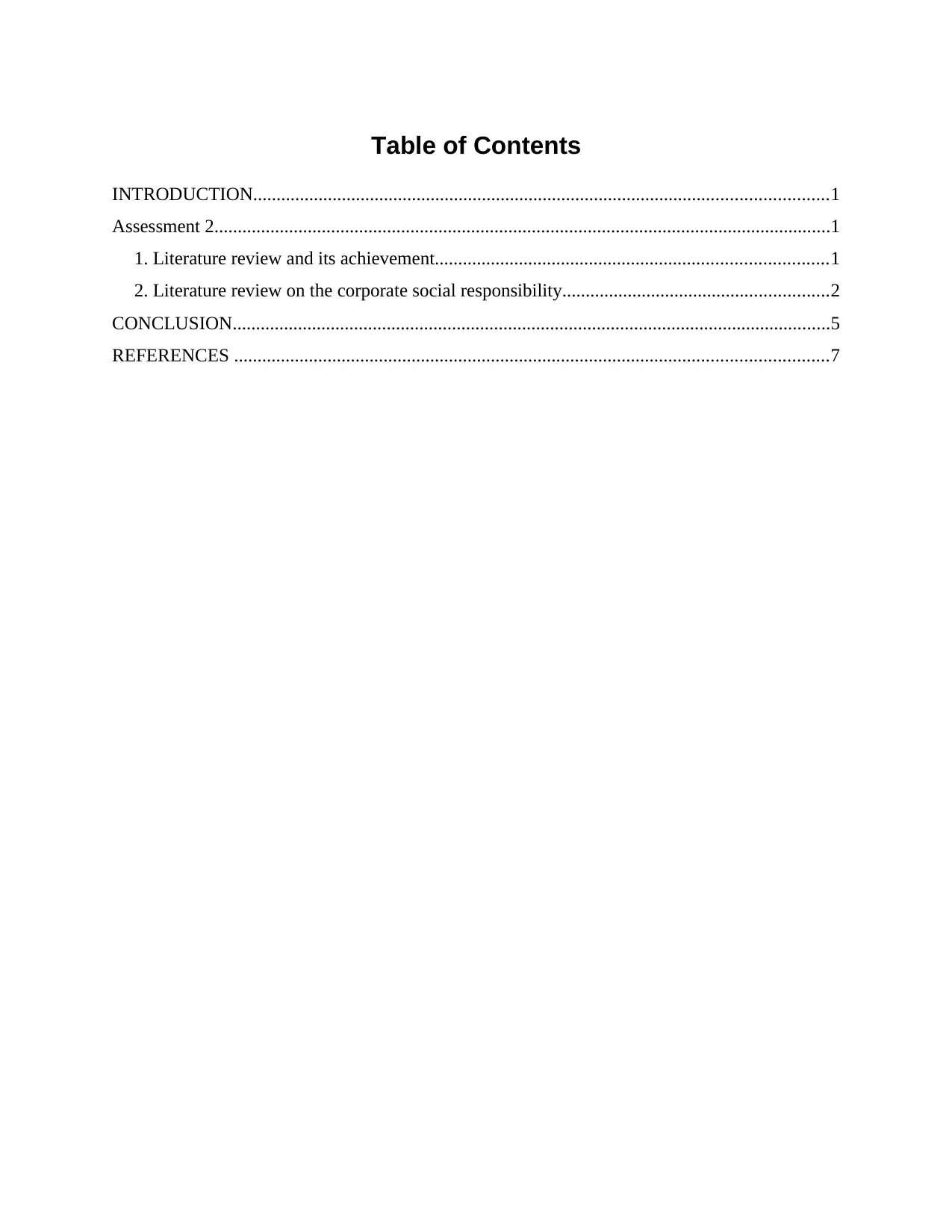
Table of Contents
INTRODUCTION...........................................................................................................................1
Assessment 2....................................................................................................................................1
1. Literature review and its achievement....................................................................................1
2. Literature review on the corporate social responsibility.........................................................2
CONCLUSION................................................................................................................................5
REFERENCES ...............................................................................................................................7
INTRODUCTION...........................................................................................................................1
Assessment 2....................................................................................................................................1
1. Literature review and its achievement....................................................................................1
2. Literature review on the corporate social responsibility.........................................................2
CONCLUSION................................................................................................................................5
REFERENCES ...............................................................................................................................7
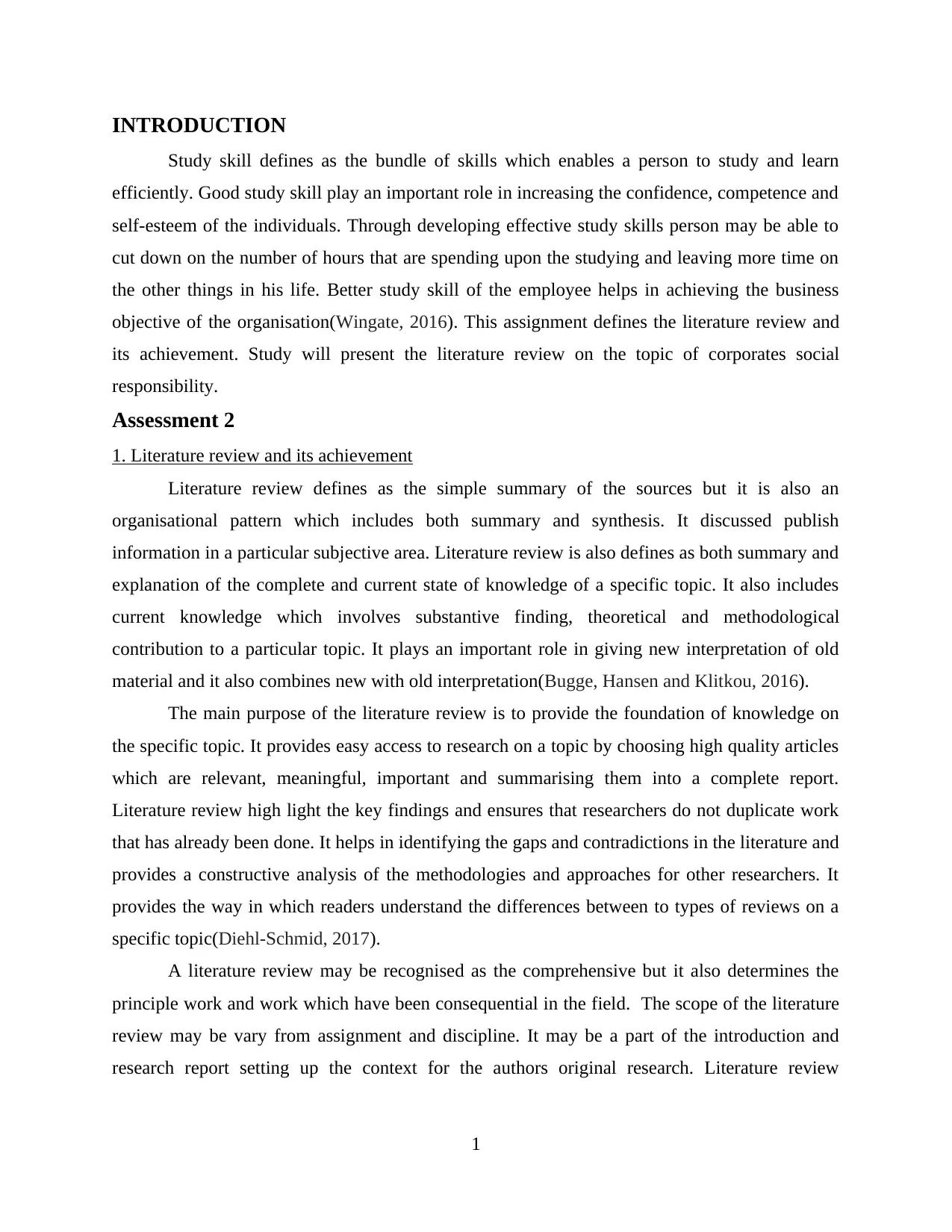
INTRODUCTION
Study skill defines as the bundle of skills which enables a person to study and learn
efficiently. Good study skill play an important role in increasing the confidence, competence and
self-esteem of the individuals. Through developing effective study skills person may be able to
cut down on the number of hours that are spending upon the studying and leaving more time on
the other things in his life. Better study skill of the employee helps in achieving the business
objective of the organisation(Wingate, 2016). This assignment defines the literature review and
its achievement. Study will present the literature review on the topic of corporates social
responsibility.
Assessment 2
1. Literature review and its achievement
Literature review defines as the simple summary of the sources but it is also an
organisational pattern which includes both summary and synthesis. It discussed publish
information in a particular subjective area. Literature review is also defines as both summary and
explanation of the complete and current state of knowledge of a specific topic. It also includes
current knowledge which involves substantive finding, theoretical and methodological
contribution to a particular topic. It plays an important role in giving new interpretation of old
material and it also combines new with old interpretation(Bugge, Hansen and Klitkou, 2016).
The main purpose of the literature review is to provide the foundation of knowledge on
the specific topic. It provides easy access to research on a topic by choosing high quality articles
which are relevant, meaningful, important and summarising them into a complete report.
Literature review high light the key findings and ensures that researchers do not duplicate work
that has already been done. It helps in identifying the gaps and contradictions in the literature and
provides a constructive analysis of the methodologies and approaches for other researchers. It
provides the way in which readers understand the differences between to types of reviews on a
specific topic(Diehl-Schmid, 2017).
A literature review may be recognised as the comprehensive but it also determines the
principle work and work which have been consequential in the field. The scope of the literature
review may be vary from assignment and discipline. It may be a part of the introduction and
research report setting up the context for the authors original research. Literature review
1
Study skill defines as the bundle of skills which enables a person to study and learn
efficiently. Good study skill play an important role in increasing the confidence, competence and
self-esteem of the individuals. Through developing effective study skills person may be able to
cut down on the number of hours that are spending upon the studying and leaving more time on
the other things in his life. Better study skill of the employee helps in achieving the business
objective of the organisation(Wingate, 2016). This assignment defines the literature review and
its achievement. Study will present the literature review on the topic of corporates social
responsibility.
Assessment 2
1. Literature review and its achievement
Literature review defines as the simple summary of the sources but it is also an
organisational pattern which includes both summary and synthesis. It discussed publish
information in a particular subjective area. Literature review is also defines as both summary and
explanation of the complete and current state of knowledge of a specific topic. It also includes
current knowledge which involves substantive finding, theoretical and methodological
contribution to a particular topic. It plays an important role in giving new interpretation of old
material and it also combines new with old interpretation(Bugge, Hansen and Klitkou, 2016).
The main purpose of the literature review is to provide the foundation of knowledge on
the specific topic. It provides easy access to research on a topic by choosing high quality articles
which are relevant, meaningful, important and summarising them into a complete report.
Literature review high light the key findings and ensures that researchers do not duplicate work
that has already been done. It helps in identifying the gaps and contradictions in the literature and
provides a constructive analysis of the methodologies and approaches for other researchers. It
provides the way in which readers understand the differences between to types of reviews on a
specific topic(Diehl-Schmid, 2017).
A literature review may be recognised as the comprehensive but it also determines the
principle work and work which have been consequential in the field. The scope of the literature
review may be vary from assignment and discipline. It may be a part of the introduction and
research report setting up the context for the authors original research. Literature review
1
⊘ This is a preview!⊘
Do you want full access?
Subscribe today to unlock all pages.

Trusted by 1+ million students worldwide
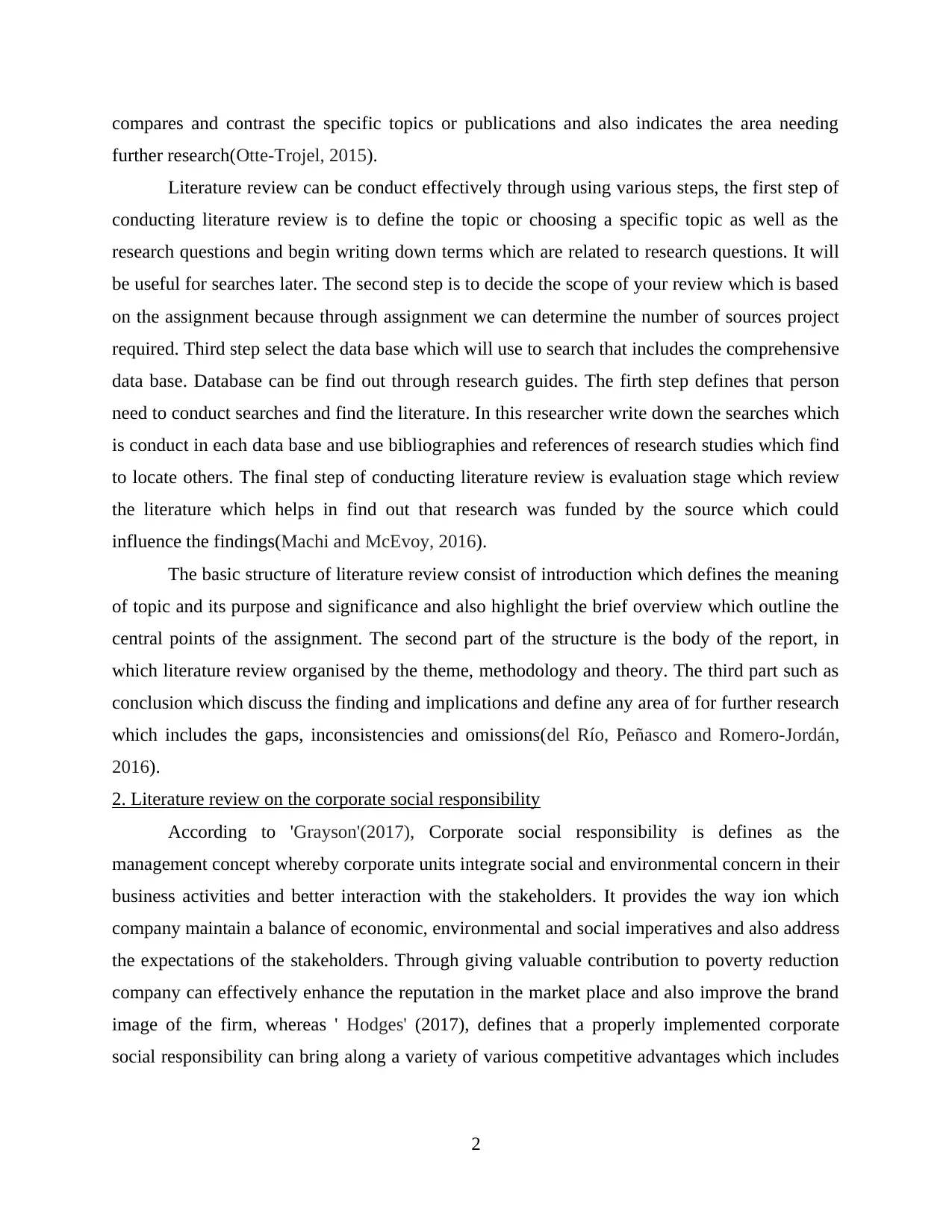
compares and contrast the specific topics or publications and also indicates the area needing
further research(Otte-Trojel, 2015).
Literature review can be conduct effectively through using various steps, the first step of
conducting literature review is to define the topic or choosing a specific topic as well as the
research questions and begin writing down terms which are related to research questions. It will
be useful for searches later. The second step is to decide the scope of your review which is based
on the assignment because through assignment we can determine the number of sources project
required. Third step select the data base which will use to search that includes the comprehensive
data base. Database can be find out through research guides. The firth step defines that person
need to conduct searches and find the literature. In this researcher write down the searches which
is conduct in each data base and use bibliographies and references of research studies which find
to locate others. The final step of conducting literature review is evaluation stage which review
the literature which helps in find out that research was funded by the source which could
influence the findings(Machi and McEvoy, 2016).
The basic structure of literature review consist of introduction which defines the meaning
of topic and its purpose and significance and also highlight the brief overview which outline the
central points of the assignment. The second part of the structure is the body of the report, in
which literature review organised by the theme, methodology and theory. The third part such as
conclusion which discuss the finding and implications and define any area of for further research
which includes the gaps, inconsistencies and omissions(del Río, Peñasco and Romero-Jordán,
2016).
2. Literature review on the corporate social responsibility
According to 'Grayson'(2017), Corporate social responsibility is defines as the
management concept whereby corporate units integrate social and environmental concern in their
business activities and better interaction with the stakeholders. It provides the way ion which
company maintain a balance of economic, environmental and social imperatives and also address
the expectations of the stakeholders. Through giving valuable contribution to poverty reduction
company can effectively enhance the reputation in the market place and also improve the brand
image of the firm, whereas ' Hodges' (2017), defines that a properly implemented corporate
social responsibility can bring along a variety of various competitive advantages which includes
2
further research(Otte-Trojel, 2015).
Literature review can be conduct effectively through using various steps, the first step of
conducting literature review is to define the topic or choosing a specific topic as well as the
research questions and begin writing down terms which are related to research questions. It will
be useful for searches later. The second step is to decide the scope of your review which is based
on the assignment because through assignment we can determine the number of sources project
required. Third step select the data base which will use to search that includes the comprehensive
data base. Database can be find out through research guides. The firth step defines that person
need to conduct searches and find the literature. In this researcher write down the searches which
is conduct in each data base and use bibliographies and references of research studies which find
to locate others. The final step of conducting literature review is evaluation stage which review
the literature which helps in find out that research was funded by the source which could
influence the findings(Machi and McEvoy, 2016).
The basic structure of literature review consist of introduction which defines the meaning
of topic and its purpose and significance and also highlight the brief overview which outline the
central points of the assignment. The second part of the structure is the body of the report, in
which literature review organised by the theme, methodology and theory. The third part such as
conclusion which discuss the finding and implications and define any area of for further research
which includes the gaps, inconsistencies and omissions(del Río, Peñasco and Romero-Jordán,
2016).
2. Literature review on the corporate social responsibility
According to 'Grayson'(2017), Corporate social responsibility is defines as the
management concept whereby corporate units integrate social and environmental concern in their
business activities and better interaction with the stakeholders. It provides the way ion which
company maintain a balance of economic, environmental and social imperatives and also address
the expectations of the stakeholders. Through giving valuable contribution to poverty reduction
company can effectively enhance the reputation in the market place and also improve the brand
image of the firm, whereas ' Hodges' (2017), defines that a properly implemented corporate
social responsibility can bring along a variety of various competitive advantages which includes
2
Paraphrase This Document
Need a fresh take? Get an instant paraphrase of this document with our AI Paraphraser
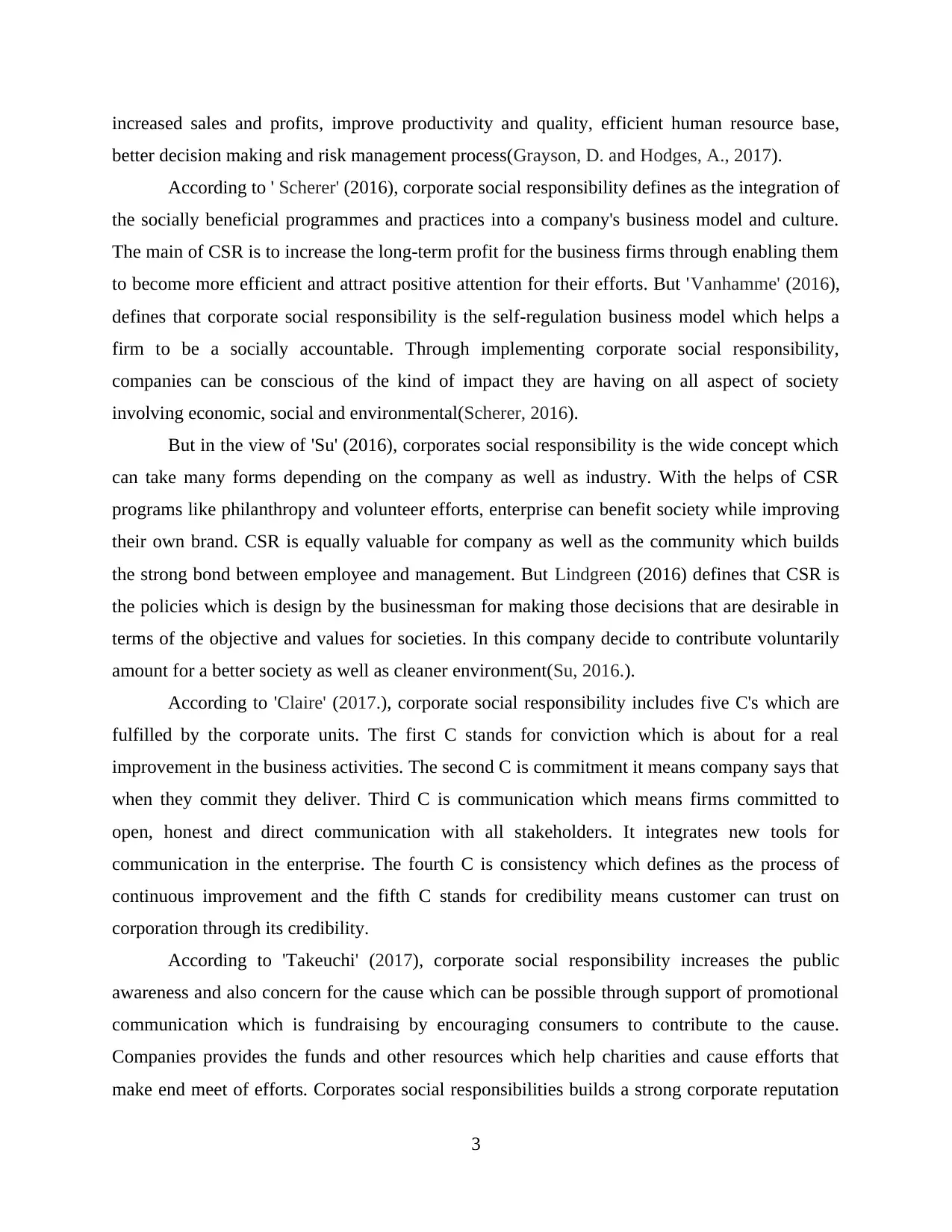
increased sales and profits, improve productivity and quality, efficient human resource base,
better decision making and risk management process(Grayson, D. and Hodges, A., 2017).
According to ' Scherer' (2016), corporate social responsibility defines as the integration of
the socially beneficial programmes and practices into a company's business model and culture.
The main of CSR is to increase the long-term profit for the business firms through enabling them
to become more efficient and attract positive attention for their efforts. But 'Vanhamme' (2016),
defines that corporate social responsibility is the self-regulation business model which helps a
firm to be a socially accountable. Through implementing corporate social responsibility,
companies can be conscious of the kind of impact they are having on all aspect of society
involving economic, social and environmental(Scherer, 2016).
But in the view of 'Su' (2016), corporates social responsibility is the wide concept which
can take many forms depending on the company as well as industry. With the helps of CSR
programs like philanthropy and volunteer efforts, enterprise can benefit society while improving
their own brand. CSR is equally valuable for company as well as the community which builds
the strong bond between employee and management. But Lindgreen (2016) defines that CSR is
the policies which is design by the businessman for making those decisions that are desirable in
terms of the objective and values for societies. In this company decide to contribute voluntarily
amount for a better society as well as cleaner environment(Su, 2016.).
According to 'Claire' (2017.), corporate social responsibility includes five C's which are
fulfilled by the corporate units. The first C stands for conviction which is about for a real
improvement in the business activities. The second C is commitment it means company says that
when they commit they deliver. Third C is communication which means firms committed to
open, honest and direct communication with all stakeholders. It integrates new tools for
communication in the enterprise. The fourth C is consistency which defines as the process of
continuous improvement and the fifth C stands for credibility means customer can trust on
corporation through its credibility.
According to 'Takeuchi' (2017), corporate social responsibility increases the public
awareness and also concern for the cause which can be possible through support of promotional
communication which is fundraising by encouraging consumers to contribute to the cause.
Companies provides the funds and other resources which help charities and cause efforts that
make end meet of efforts. Corporates social responsibilities builds a strong corporate reputation
3
better decision making and risk management process(Grayson, D. and Hodges, A., 2017).
According to ' Scherer' (2016), corporate social responsibility defines as the integration of
the socially beneficial programmes and practices into a company's business model and culture.
The main of CSR is to increase the long-term profit for the business firms through enabling them
to become more efficient and attract positive attention for their efforts. But 'Vanhamme' (2016),
defines that corporate social responsibility is the self-regulation business model which helps a
firm to be a socially accountable. Through implementing corporate social responsibility,
companies can be conscious of the kind of impact they are having on all aspect of society
involving economic, social and environmental(Scherer, 2016).
But in the view of 'Su' (2016), corporates social responsibility is the wide concept which
can take many forms depending on the company as well as industry. With the helps of CSR
programs like philanthropy and volunteer efforts, enterprise can benefit society while improving
their own brand. CSR is equally valuable for company as well as the community which builds
the strong bond between employee and management. But Lindgreen (2016) defines that CSR is
the policies which is design by the businessman for making those decisions that are desirable in
terms of the objective and values for societies. In this company decide to contribute voluntarily
amount for a better society as well as cleaner environment(Su, 2016.).
According to 'Claire' (2017.), corporate social responsibility includes five C's which are
fulfilled by the corporate units. The first C stands for conviction which is about for a real
improvement in the business activities. The second C is commitment it means company says that
when they commit they deliver. Third C is communication which means firms committed to
open, honest and direct communication with all stakeholders. It integrates new tools for
communication in the enterprise. The fourth C is consistency which defines as the process of
continuous improvement and the fifth C stands for credibility means customer can trust on
corporation through its credibility.
According to 'Takeuchi' (2017), corporate social responsibility increases the public
awareness and also concern for the cause which can be possible through support of promotional
communication which is fundraising by encouraging consumers to contribute to the cause.
Companies provides the funds and other resources which help charities and cause efforts that
make end meet of efforts. Corporates social responsibilities builds a strong corporate reputation
3
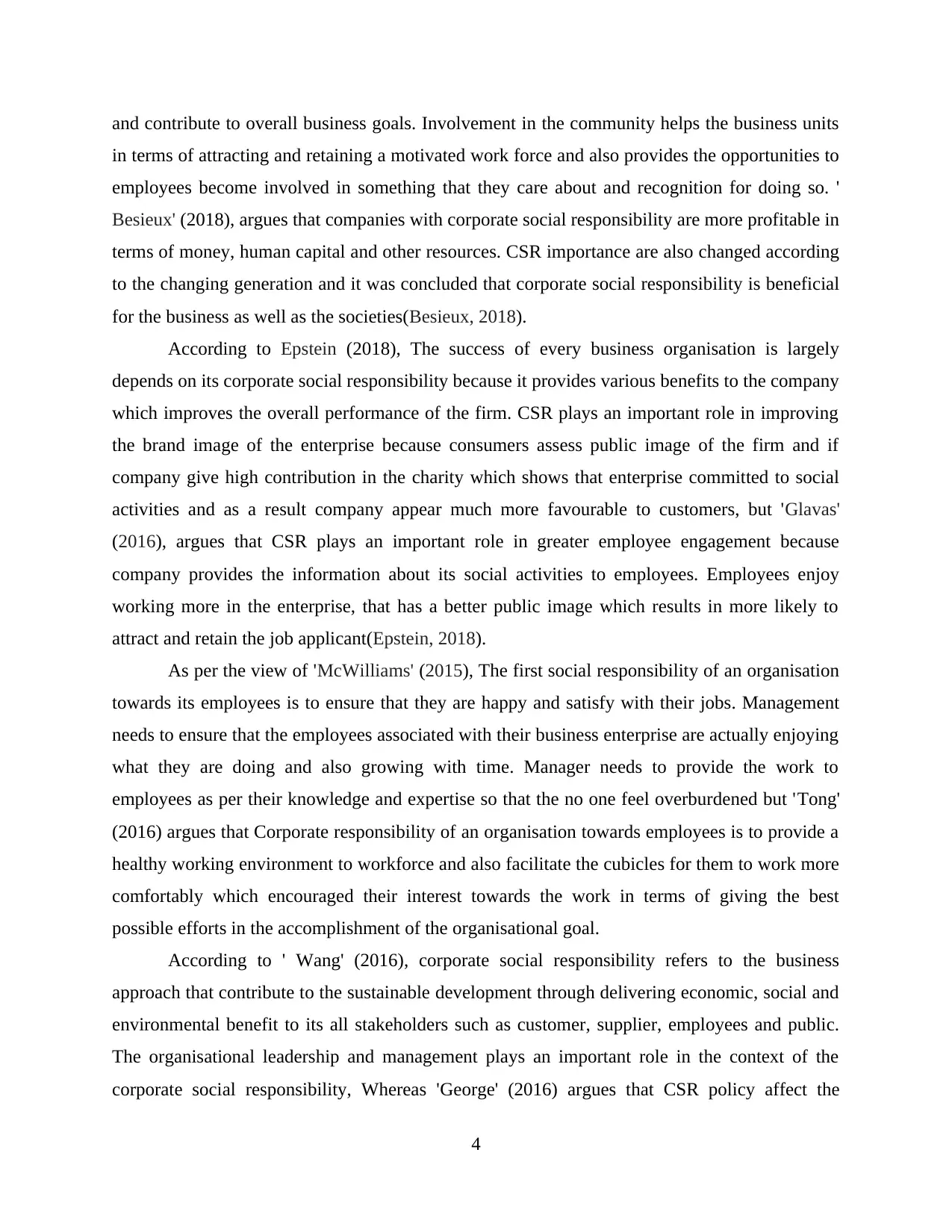
and contribute to overall business goals. Involvement in the community helps the business units
in terms of attracting and retaining a motivated work force and also provides the opportunities to
employees become involved in something that they care about and recognition for doing so. '
Besieux' (2018), argues that companies with corporate social responsibility are more profitable in
terms of money, human capital and other resources. CSR importance are also changed according
to the changing generation and it was concluded that corporate social responsibility is beneficial
for the business as well as the societies(Besieux, 2018).
According to Epstein (2018), The success of every business organisation is largely
depends on its corporate social responsibility because it provides various benefits to the company
which improves the overall performance of the firm. CSR plays an important role in improving
the brand image of the enterprise because consumers assess public image of the firm and if
company give high contribution in the charity which shows that enterprise committed to social
activities and as a result company appear much more favourable to customers, but 'Glavas'
(2016), argues that CSR plays an important role in greater employee engagement because
company provides the information about its social activities to employees. Employees enjoy
working more in the enterprise, that has a better public image which results in more likely to
attract and retain the job applicant(Epstein, 2018).
As per the view of 'McWilliams' (2015), The first social responsibility of an organisation
towards its employees is to ensure that they are happy and satisfy with their jobs. Management
needs to ensure that the employees associated with their business enterprise are actually enjoying
what they are doing and also growing with time. Manager needs to provide the work to
employees as per their knowledge and expertise so that the no one feel overburdened but 'Tong'
(2016) argues that Corporate responsibility of an organisation towards employees is to provide a
healthy working environment to workforce and also facilitate the cubicles for them to work more
comfortably which encouraged their interest towards the work in terms of giving the best
possible efforts in the accomplishment of the organisational goal.
According to ' Wang' (2016), corporate social responsibility refers to the business
approach that contribute to the sustainable development through delivering economic, social and
environmental benefit to its all stakeholders such as customer, supplier, employees and public.
The organisational leadership and management plays an important role in the context of the
corporate social responsibility, Whereas 'George' (2016) argues that CSR policy affect the
4
in terms of attracting and retaining a motivated work force and also provides the opportunities to
employees become involved in something that they care about and recognition for doing so. '
Besieux' (2018), argues that companies with corporate social responsibility are more profitable in
terms of money, human capital and other resources. CSR importance are also changed according
to the changing generation and it was concluded that corporate social responsibility is beneficial
for the business as well as the societies(Besieux, 2018).
According to Epstein (2018), The success of every business organisation is largely
depends on its corporate social responsibility because it provides various benefits to the company
which improves the overall performance of the firm. CSR plays an important role in improving
the brand image of the enterprise because consumers assess public image of the firm and if
company give high contribution in the charity which shows that enterprise committed to social
activities and as a result company appear much more favourable to customers, but 'Glavas'
(2016), argues that CSR plays an important role in greater employee engagement because
company provides the information about its social activities to employees. Employees enjoy
working more in the enterprise, that has a better public image which results in more likely to
attract and retain the job applicant(Epstein, 2018).
As per the view of 'McWilliams' (2015), The first social responsibility of an organisation
towards its employees is to ensure that they are happy and satisfy with their jobs. Management
needs to ensure that the employees associated with their business enterprise are actually enjoying
what they are doing and also growing with time. Manager needs to provide the work to
employees as per their knowledge and expertise so that the no one feel overburdened but 'Tong'
(2016) argues that Corporate responsibility of an organisation towards employees is to provide a
healthy working environment to workforce and also facilitate the cubicles for them to work more
comfortably which encouraged their interest towards the work in terms of giving the best
possible efforts in the accomplishment of the organisational goal.
According to ' Wang' (2016), corporate social responsibility refers to the business
approach that contribute to the sustainable development through delivering economic, social and
environmental benefit to its all stakeholders such as customer, supplier, employees and public.
The organisational leadership and management plays an important role in the context of the
corporate social responsibility, Whereas 'George' (2016) argues that CSR policy affect the
4
⊘ This is a preview!⊘
Do you want full access?
Subscribe today to unlock all pages.

Trusted by 1+ million students worldwide
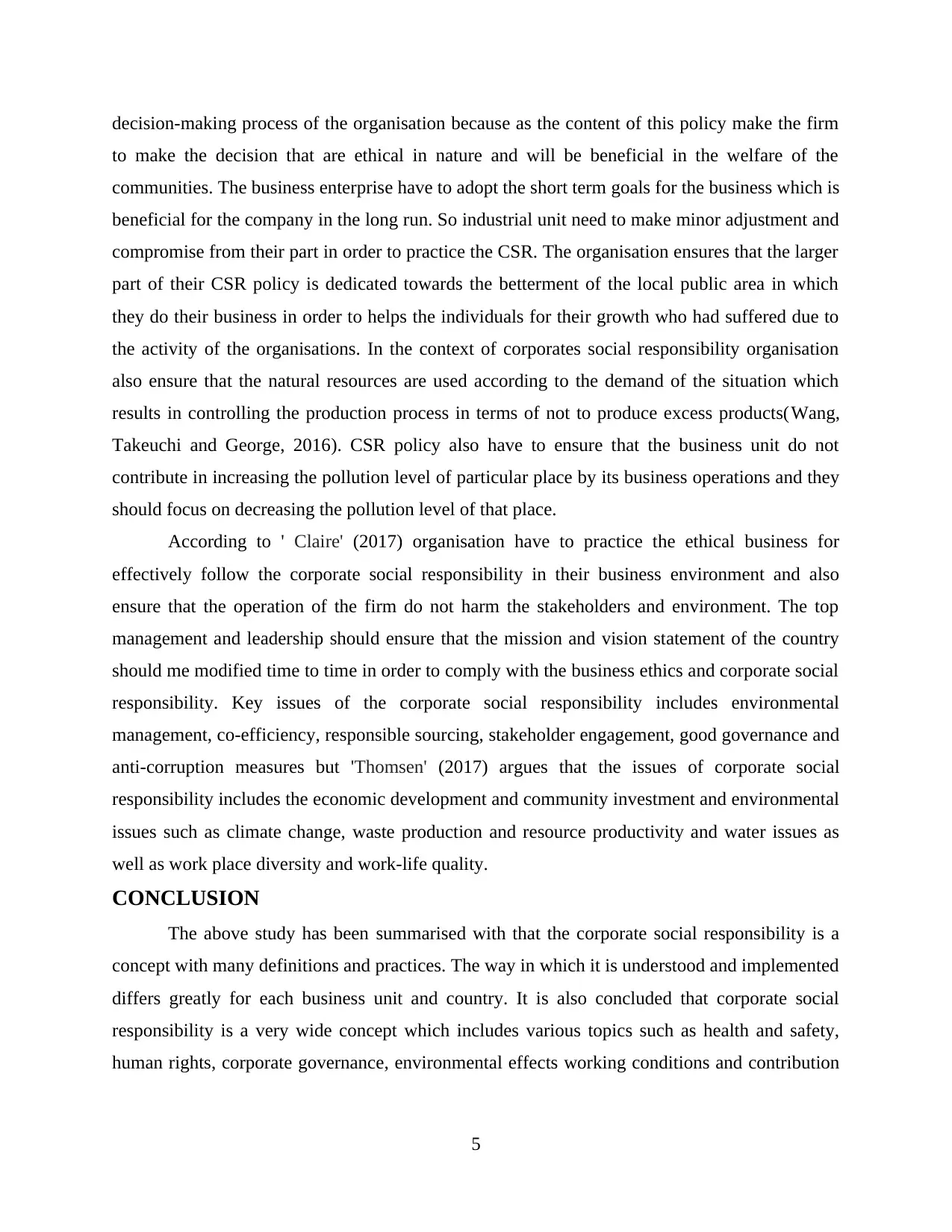
decision-making process of the organisation because as the content of this policy make the firm
to make the decision that are ethical in nature and will be beneficial in the welfare of the
communities. The business enterprise have to adopt the short term goals for the business which is
beneficial for the company in the long run. So industrial unit need to make minor adjustment and
compromise from their part in order to practice the CSR. The organisation ensures that the larger
part of their CSR policy is dedicated towards the betterment of the local public area in which
they do their business in order to helps the individuals for their growth who had suffered due to
the activity of the organisations. In the context of corporates social responsibility organisation
also ensure that the natural resources are used according to the demand of the situation which
results in controlling the production process in terms of not to produce excess products(Wang,
Takeuchi and George, 2016). CSR policy also have to ensure that the business unit do not
contribute in increasing the pollution level of particular place by its business operations and they
should focus on decreasing the pollution level of that place.
According to ' Claire' (2017) organisation have to practice the ethical business for
effectively follow the corporate social responsibility in their business environment and also
ensure that the operation of the firm do not harm the stakeholders and environment. The top
management and leadership should ensure that the mission and vision statement of the country
should me modified time to time in order to comply with the business ethics and corporate social
responsibility. Key issues of the corporate social responsibility includes environmental
management, co-efficiency, responsible sourcing, stakeholder engagement, good governance and
anti-corruption measures but 'Thomsen' (2017) argues that the issues of corporate social
responsibility includes the economic development and community investment and environmental
issues such as climate change, waste production and resource productivity and water issues as
well as work place diversity and work-life quality.
CONCLUSION
The above study has been summarised with that the corporate social responsibility is a
concept with many definitions and practices. The way in which it is understood and implemented
differs greatly for each business unit and country. It is also concluded that corporate social
responsibility is a very wide concept which includes various topics such as health and safety,
human rights, corporate governance, environmental effects working conditions and contribution
5
to make the decision that are ethical in nature and will be beneficial in the welfare of the
communities. The business enterprise have to adopt the short term goals for the business which is
beneficial for the company in the long run. So industrial unit need to make minor adjustment and
compromise from their part in order to practice the CSR. The organisation ensures that the larger
part of their CSR policy is dedicated towards the betterment of the local public area in which
they do their business in order to helps the individuals for their growth who had suffered due to
the activity of the organisations. In the context of corporates social responsibility organisation
also ensure that the natural resources are used according to the demand of the situation which
results in controlling the production process in terms of not to produce excess products(Wang,
Takeuchi and George, 2016). CSR policy also have to ensure that the business unit do not
contribute in increasing the pollution level of particular place by its business operations and they
should focus on decreasing the pollution level of that place.
According to ' Claire' (2017) organisation have to practice the ethical business for
effectively follow the corporate social responsibility in their business environment and also
ensure that the operation of the firm do not harm the stakeholders and environment. The top
management and leadership should ensure that the mission and vision statement of the country
should me modified time to time in order to comply with the business ethics and corporate social
responsibility. Key issues of the corporate social responsibility includes environmental
management, co-efficiency, responsible sourcing, stakeholder engagement, good governance and
anti-corruption measures but 'Thomsen' (2017) argues that the issues of corporate social
responsibility includes the economic development and community investment and environmental
issues such as climate change, waste production and resource productivity and water issues as
well as work place diversity and work-life quality.
CONCLUSION
The above study has been summarised with that the corporate social responsibility is a
concept with many definitions and practices. The way in which it is understood and implemented
differs greatly for each business unit and country. It is also concluded that corporate social
responsibility is a very wide concept which includes various topics such as health and safety,
human rights, corporate governance, environmental effects working conditions and contribution
5
Paraphrase This Document
Need a fresh take? Get an instant paraphrase of this document with our AI Paraphraser

to the economic development. The main purpose of the is to drive changes towards
sustainability.
6
sustainability.
6
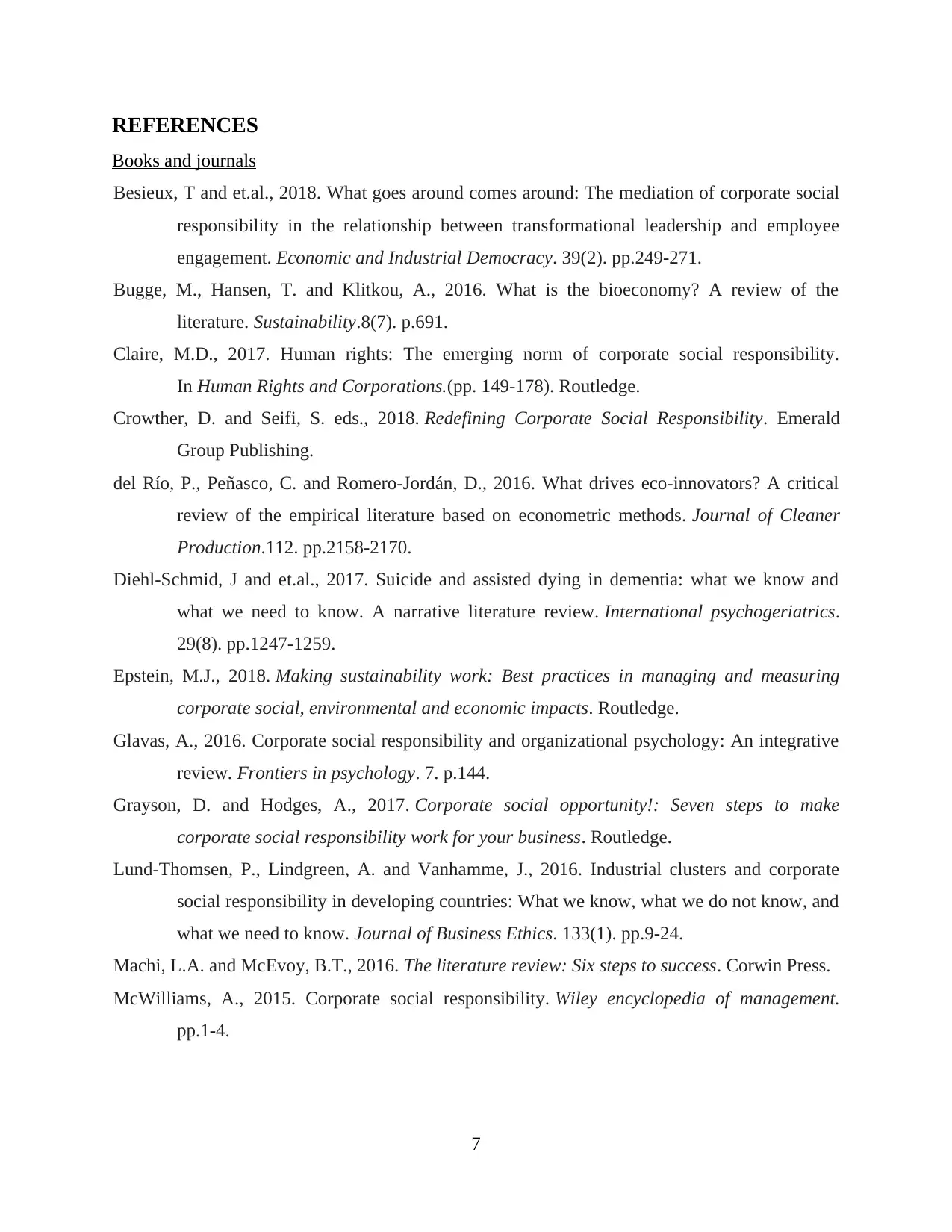
REFERENCES
Books and journals
Besieux, T and et.al., 2018. What goes around comes around: The mediation of corporate social
responsibility in the relationship between transformational leadership and employee
engagement. Economic and Industrial Democracy. 39(2). pp.249-271.
Bugge, M., Hansen, T. and Klitkou, A., 2016. What is the bioeconomy? A review of the
literature. Sustainability.8(7). p.691.
Claire, M.D., 2017. Human rights: The emerging norm of corporate social responsibility.
In Human Rights and Corporations.(pp. 149-178). Routledge.
Crowther, D. and Seifi, S. eds., 2018. Redefining Corporate Social Responsibility. Emerald
Group Publishing.
del Río, P., Peñasco, C. and Romero-Jordán, D., 2016. What drives eco-innovators? A critical
review of the empirical literature based on econometric methods. Journal of Cleaner
Production.112. pp.2158-2170.
Diehl-Schmid, J and et.al., 2017. Suicide and assisted dying in dementia: what we know and
what we need to know. A narrative literature review. International psychogeriatrics.
29(8). pp.1247-1259.
Epstein, M.J., 2018. Making sustainability work: Best practices in managing and measuring
corporate social, environmental and economic impacts. Routledge.
Glavas, A., 2016. Corporate social responsibility and organizational psychology: An integrative
review. Frontiers in psychology. 7. p.144.
Grayson, D. and Hodges, A., 2017. Corporate social opportunity!: Seven steps to make
corporate social responsibility work for your business. Routledge.
Lund-Thomsen, P., Lindgreen, A. and Vanhamme, J., 2016. Industrial clusters and corporate
social responsibility in developing countries: What we know, what we do not know, and
what we need to know. Journal of Business Ethics. 133(1). pp.9-24.
Machi, L.A. and McEvoy, B.T., 2016. The literature review: Six steps to success. Corwin Press.
McWilliams, A., 2015. Corporate social responsibility. Wiley encyclopedia of management.
pp.1-4.
7
Books and journals
Besieux, T and et.al., 2018. What goes around comes around: The mediation of corporate social
responsibility in the relationship between transformational leadership and employee
engagement. Economic and Industrial Democracy. 39(2). pp.249-271.
Bugge, M., Hansen, T. and Klitkou, A., 2016. What is the bioeconomy? A review of the
literature. Sustainability.8(7). p.691.
Claire, M.D., 2017. Human rights: The emerging norm of corporate social responsibility.
In Human Rights and Corporations.(pp. 149-178). Routledge.
Crowther, D. and Seifi, S. eds., 2018. Redefining Corporate Social Responsibility. Emerald
Group Publishing.
del Río, P., Peñasco, C. and Romero-Jordán, D., 2016. What drives eco-innovators? A critical
review of the empirical literature based on econometric methods. Journal of Cleaner
Production.112. pp.2158-2170.
Diehl-Schmid, J and et.al., 2017. Suicide and assisted dying in dementia: what we know and
what we need to know. A narrative literature review. International psychogeriatrics.
29(8). pp.1247-1259.
Epstein, M.J., 2018. Making sustainability work: Best practices in managing and measuring
corporate social, environmental and economic impacts. Routledge.
Glavas, A., 2016. Corporate social responsibility and organizational psychology: An integrative
review. Frontiers in psychology. 7. p.144.
Grayson, D. and Hodges, A., 2017. Corporate social opportunity!: Seven steps to make
corporate social responsibility work for your business. Routledge.
Lund-Thomsen, P., Lindgreen, A. and Vanhamme, J., 2016. Industrial clusters and corporate
social responsibility in developing countries: What we know, what we do not know, and
what we need to know. Journal of Business Ethics. 133(1). pp.9-24.
Machi, L.A. and McEvoy, B.T., 2016. The literature review: Six steps to success. Corwin Press.
McWilliams, A., 2015. Corporate social responsibility. Wiley encyclopedia of management.
pp.1-4.
7
⊘ This is a preview!⊘
Do you want full access?
Subscribe today to unlock all pages.

Trusted by 1+ million students worldwide
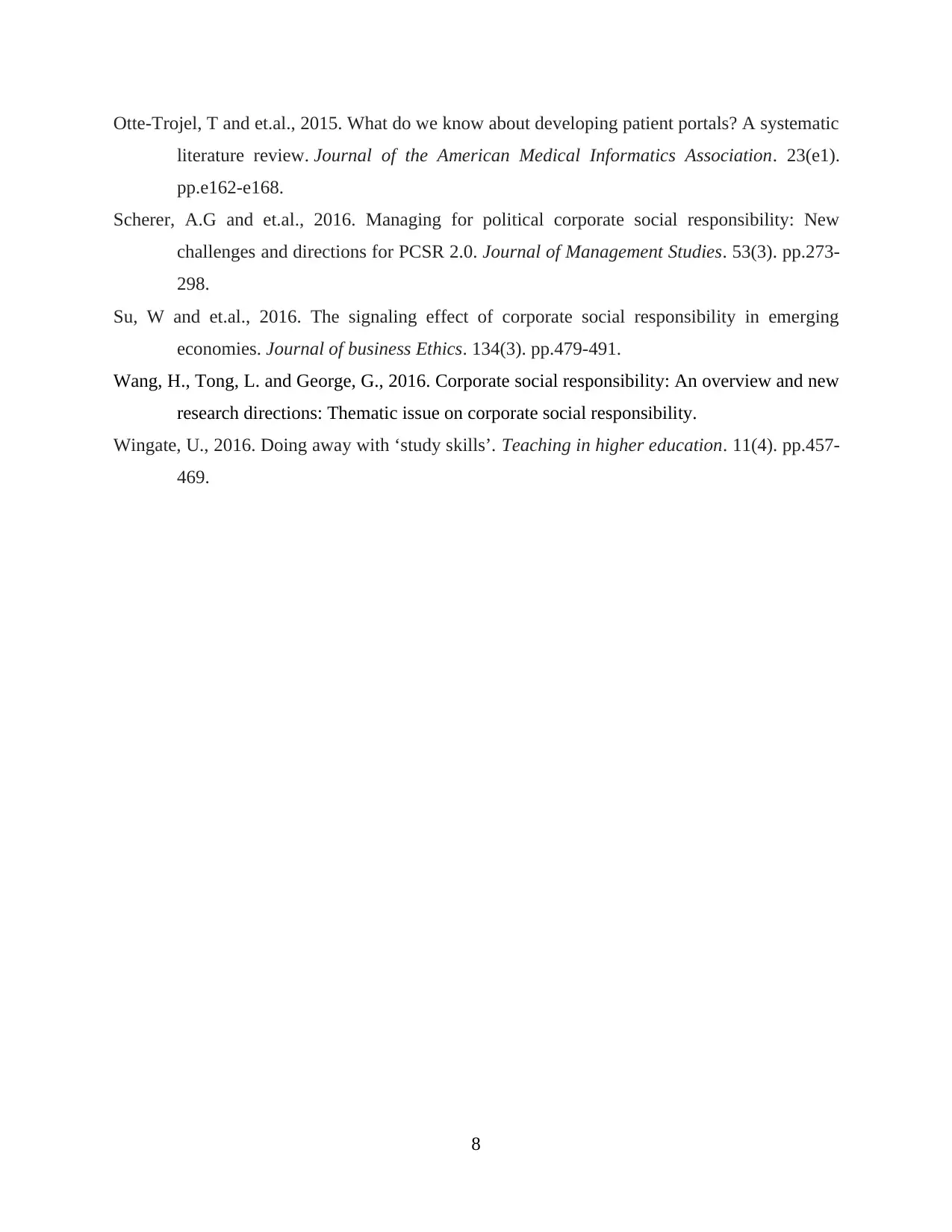
Otte-Trojel, T and et.al., 2015. What do we know about developing patient portals? A systematic
literature review. Journal of the American Medical Informatics Association. 23(e1).
pp.e162-e168.
Scherer, A.G and et.al., 2016. Managing for political corporate social responsibility: New
challenges and directions for PCSR 2.0. Journal of Management Studies. 53(3). pp.273-
298.
Su, W and et.al., 2016. The signaling effect of corporate social responsibility in emerging
economies. Journal of business Ethics. 134(3). pp.479-491.
Wang, H., Tong, L. and George, G., 2016. Corporate social responsibility: An overview and new
research directions: Thematic issue on corporate social responsibility.
Wingate, U., 2016. Doing away with ‘study skills’. Teaching in higher education. 11(4). pp.457-
469.
8
literature review. Journal of the American Medical Informatics Association. 23(e1).
pp.e162-e168.
Scherer, A.G and et.al., 2016. Managing for political corporate social responsibility: New
challenges and directions for PCSR 2.0. Journal of Management Studies. 53(3). pp.273-
298.
Su, W and et.al., 2016. The signaling effect of corporate social responsibility in emerging
economies. Journal of business Ethics. 134(3). pp.479-491.
Wang, H., Tong, L. and George, G., 2016. Corporate social responsibility: An overview and new
research directions: Thematic issue on corporate social responsibility.
Wingate, U., 2016. Doing away with ‘study skills’. Teaching in higher education. 11(4). pp.457-
469.
8
1 out of 10
Related Documents
Your All-in-One AI-Powered Toolkit for Academic Success.
+13062052269
info@desklib.com
Available 24*7 on WhatsApp / Email
![[object Object]](/_next/static/media/star-bottom.7253800d.svg)
Unlock your academic potential
Copyright © 2020–2025 A2Z Services. All Rights Reserved. Developed and managed by ZUCOL.





